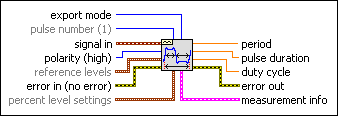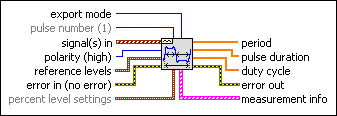 |
export mode specifies whether this VI returns the period or duty cycle outputs.
| 0 | all (default)–Returns period, pulse duration, duty cycle, and measurement info. | | 1 | no period and duty cycle–Returns pulse duration and measurement info but does not return period or duty cycle. |
|
 |
pulse number specifies which pulse of polarity, high or low, LabVIEW measures. For pulse number n with polarity low, the VI measures the pulse duration and center of the nth low pulse. The VI measures the period and duty cycle of the period that begins with the (2n – 1)th mid ref level crossing.
|
 |
signal in is the waveform to measure. The waveform must contain at least pulse number complete cycles, where a cycle is the interval between two consecutive mid ref level crossings in the same direction.
|
 |
polarity defines a pulse as high (default) or low. A high pulse consists of the interval between a rising mid ref level crossing and the next falling mid ref level crossing.
|
 |
reference levels specifies the high, middle, and low reference levels of a waveform. LabVIEW uses the reference levels to define the measurement interval of one complete cycle. The distance between the mid ref level and the high ref level must equal the distance between the low ref level and the mid ref level. If the two distances are not equal, LabVIEW adjusts either the high ref level or the low ref level to match the smaller of the two distances. For example, if you specify a high ref level of 90%, a mid ref level of 50%, and a low ref level of 20%, LabVIEW uses 80% instead of 90% for the high ref level.
 |
high ref level specifies the high reference level of the waveform in percent (default) or absolute units. After the signal crosses the mid ref level in the rising direction, it must cross the high ref level before the next falling mid ref level crossing can be counted.
|
 |
mid ref level specifies the middle reference level in percent (default) or absolute units. The interval between consecutive rising mid ref level crossings defines one cycle, or period, of the waveform. At least one high/low reference level crossing must separate each mid ref level crossing.
|
 |
low ref level specifies the low reference level of the waveform in percent (default) or absolute units. After the signal crosses the mid ref level in the falling direction, it must cross the low ref level before the next rising mid ref level crossing can be counted.
|
 |
ref units specifies whether the high ref level, mid ref level, and low ref level inputs are interpreted as a percentage (default) of the full range of the waveform or as absolute levels.
|
|
 |
error in describes error conditions that occur before this node runs. This input provides standard error in functionality.
|
 |
percent level settings specifies the method LabVIEW uses to determine the high and low state levels of a waveform. If you select percent ref units, percent level settings determines the reference levels. Otherwise, LabVIEW ignores this input.
 |
method specifies how LabVIEW computes the high and low state levels of the waveform.
| 0 | Histogram—Returns the levels of the histogram bins with the maximum number of hits in the upper and lower regions of the waveform. The upper and lower regions of the waveform include the upper and lower 40%, respectively, of the peak-to-peak range of the waveform. | | 1 | Peak—Searches the entire waveform for its maximum and minimum levels. | | 2 | Auto select (default)—Determines whether the histogram bins that correspond to the high and low state levels each have over 5% of the total hits. If so, LabVIEW returns those results. Otherwise, LabVIEW uses the peak method. This ensures a reasonable answer for either a square wave (ignoring the overshoot and undershoot) or a triangle wave (where a histogram fails). |
|
 |
histogram size specifies the number of bins in the histogram LabVIEW uses to determine the high and low state levels of the waveform.
|
 |
histogram method specifies how LabVIEW computes the high and low state levels of the waveform. Currently, mode is the only available histogram method.
|
 |
reserved is reserved for future use.
|
|
 |
period returns the time between adjacent mid ref level crossings in the same direction in seconds. The reciprocal of this value is the signal frequency. The measurement interval includes the pulse you specify in pulse number.
|
 |
pulse duration is the time difference in seconds between the first two mid ref level crossings of the pulse number. pulse duration is also known as pulse width.
|
 |
duty cycle is a fraction of a period. duty cycle is also known as duty factor. LabVIEW uses the following equation to calculate duty cycle:

In this equation, pulse duration can refer to the high or low portion of the period, depending on whether polarity is high pulse or low pulse.
|
 |
error out contains error information. This output provides standard error out functionality.
|
 |
measurement info returns the pulse-center time of the selected pulse and the absolute reference levels LabVIEW uses to define the measurement cycle.
|
 |
export mode specifies whether this VI returns the period or duty cycle outputs.
| 0 | all (default)–Returns period, pulse duration, duty cycle, and measurement info. | | 1 | no period and duty cycle–Returns pulse duration and measurement info but does not return period or duty cycle. |
|
 |
pulse number specifies which pulse of polarity, high or low, LabVIEW measures. For pulse number n with polarity low, the VI measures the pulse duration and center of the nth low pulse. The VI measures the period and duty cycle of the period that begins with the (2n – 1)th mid ref level crossing.
|
 |
signal(s) in is the array of waveforms to measure. The waveform must contain at least pulse number complete cycles, where a cycle is the interval between two consecutive mid ref level crossings in the same direction.
|
 |
polarity defines a pulse as high (default) or low. A high pulse consists of the interval between a rising mid ref level crossing and the next falling mid ref level crossing.
|
 |
reference levels specifies the high, middle, and low reference levels of a waveform. LabVIEW uses the reference levels to define the measurement interval of one complete cycle. The distance between the mid ref level and the high ref level must equal the distance between the low ref level and the mid ref level. If the two distances are not equal, LabVIEW adjusts either the high ref level or the low ref level to match the smaller of the two distances. For example, if you specify a high ref level of 90%, a mid ref level of 50%, and a low ref level of 20%, LabVIEW uses 80% instead of 90% for the high ref level.
 |
high ref level specifies the high reference level of the waveform in percent (default) or absolute units. After the signal crosses the mid ref level in the rising direction, it must cross the high ref level before the next falling mid ref level crossing can be counted.
|
 |
mid ref level specifies the middle reference level in percent (default) or absolute units. The interval between consecutive rising mid ref level crossings defines one cycle, or period, of the waveform. At least one high/low reference level crossing must separate each mid ref level crossing.
|
 |
low ref level specifies the low reference level of the waveform in percent (default) or absolute units. After the signal crosses the mid ref level in the falling direction, it must cross the low ref level before the next rising mid ref level crossing can be counted.
|
 |
ref units specifies whether the high ref level, mid ref level, and low ref level inputs are interpreted as a percentage (default) of the full range of the waveform or as absolute levels.
|
|
 |
error in describes error conditions that occur before this node runs. This input provides standard error in functionality.
|
 |
percent level settings specifies the method LabVIEW uses to determine the high and low state levels of a waveform. If you select percent ref units, percent level settings determines the reference levels. Otherwise, LabVIEW ignores this input.
 |
method specifies how LabVIEW computes the high and low state levels of the waveform.
| 0 | Histogram—Returns the levels of the histogram bins with the maximum number of hits in the upper and lower regions of the waveform. The upper and lower regions of the waveform include the upper and lower 40%, respectively, of the peak-to-peak range of the waveform. | | 1 | Peak—Searches the entire waveform for its maximum and minimum levels. | | 2 | Auto select (default)—Determines whether the histogram bins that correspond to the high and low state levels each have over 5% of the total hits. If so, LabVIEW returns those results. Otherwise, LabVIEW uses the peak method. This ensures a reasonable answer for either a square wave (ignoring the overshoot and undershoot) or a triangle wave (where a histogram fails). |
|
 |
histogram size specifies the number of bins in the histogram LabVIEW uses to determine the high and low state levels of the waveform.
|
 |
histogram method specifies how LabVIEW computes the high and low state levels of the waveform. Currently, mode is the only available histogram method.
|
 |
reserved is reserved for future use.
|
|
 |
period is an array that contains the period for each waveform in signal(s) in. period returns the time between adjacent mid ref level crossings in the same direction in seconds. The reciprocal of this value is the signal frequency. The measurement interval includes the pulse you specify in pulse number.
|
 |
pulse duration is an array that contains the pulse duration for each waveform in signal(s) in. pulse duration is the time difference in seconds between the first two mid ref level crossings of the pulse number. pulse duration is also known as pulse width.
|
 |
duty cycle is an array that contains the duty cycle for each waveform in signal(s) in. duty cycle is also known as duty factor. LabVIEW uses the following equation to calculate duty cycle:

In this equation, pulse duration can refer to the high or low portion of the period, depending on whether polarity is high pulse or low pulse.
|
 |
error out contains error information. This output provides standard error out functionality.
|
 |
measurement info is an array of clusters that returns the pulse center time of the selected pulse and the absolute reference levels LabVIEW uses to define the measurement cycle for each input waveform.
|

 Add to the block diagram
Add to the block diagram Find on the palette
Find on the palette


















